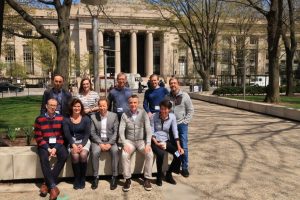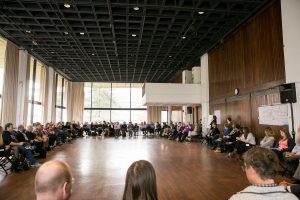Late April 2019 an illustrious cohort of 76 creative, passionate, and engaged educators, thought leaders, educational entrepreneurs, directors, administrators, students and change makers from 16 institutions from around the world gathered at MIT and Olin College. Their purpose was to get a common understanding of what needs to be done to educate engineers to be prepared for the next 20 years, and identify the main items of leverage.
The programme for the two-day meeting: Mapping the future 20 years from now – Identifying strategic themes – Co-designing safe-to-fail pilots.
The Global state of the art in engineering education
In March 2018 Ruth Graham released the report on The Global State of the Art in Engineering Education, commissioned by the MIT NEET (New Engineering Education Transformation) Program. It triggered conversation across the globe. It provides a snapshot of the cutting edge of global engineering education and a horizon scan of how the state of the art is likely to develop in the future, and includes in-depth case studies at four institutions that had been identified as being the “emerging leaders” in engineering education by 50 global thought leaders. TU Delft was one of them.

The Delft crew for the colloquium on the global state of engineering education at MIT (private photo)
One year later after its publication the MIT NEET Program and the Olin College of Engineering invited the 16 institutions that had been named as the leaders in engineering education, to send representatives for a first-of-its kind Colloquium on the Global State of the Art in Engineering Education. Together with seven higher educational management colleagues of TU Delft and two students I joined this cohort.
Mapping the future 20 years from now
In the first mapping session, the participants came forward with a wide spectrum of topics. More than I had expected were related to educating “the whole” engineering student. It means teaching should not be limited to the traditional mono-disciplinary technical proficiency. It should also be about the development of life skills, about a mindset of social responsibility and the UN Sustainability Design Goals (UN SDG), about the study climate with attention for health, well-being and performance in the engineering educational system. In brief, developing learners into “human engineers”, always grounded in engineering fundamentals to be prepared to design solutions for problems in the real world and have a solid basis for lifelong learning.
Other trending topics focus on empowering the students. To develop them “from empty vessels” into independent learners, encourage them to be conscious and teach themselves what they need to know in the face of ambiguously defined problems. Many ideas were brought forward to make the students the change agent for innovations in engineering education or even strategic faculty development. Major related issues are the emerging needs for much more individualised learning paths and the associated demands for coaching, tracking and assessment of achievements.

Shuffling and categorising the many challenges (photo MIT/Olin College)
20 years from now?
After the facilitators had reshuffled and categorized the dozens of topics that were brought forward by the participants into 12 main challenges, I had a moment where I wondered if these were indeed the main challenges that would be a key drive to prepare engineering education for the next 20 years. I had the feeling that most of them should already be addressed today. I had expected we would have to grow very different subjects in engineering education to be prepared for the next 20 years.
It shows the enormous variety in educational systems and cultures worldwide, even among the leading institutes in engineering education. Some universities are in the process to develop experiential learning and global experiences at scale, some universities are mainly concerned about enjoyment and engagement in classes, and others about the removal of barriers for minority groups to get access to engineering programmes and integrate diverse populations for equity and justice. Not all challenges are equally important for all universities.
The future as a linear extension of the present
Many of the trending topics that were mentioned already apply, or at least should apply, to today’s challenges in education, or say within five years from now. I was surprised that most participants seem to consider the future of 20 years as a linear extension of the present. Should not we expect that in today’s rapidly changing world, where the pace of change technology and bioscience is ever accelerating, in 20 years we will live and work in an environment we can hardly imagine?
The impact of the Artificial Intelligence for example on education could be massive. Its challenge will be to get users to adapt and adopt to AI as an emerging technology in didactics. It will enable the automation of teacher’s routine tasks, optimise group formation for learning objectives, personalised learning. It will help students and graduates highlight their strengths and weaknesses, and anticipate job market demands. It will shift from the stop-and-test model to continuous learning cadenced by virtual coaches and tutors.
In the engineering profession we shall not underestimate the impact of working symbiotically with intelligent and learning machines and its impact on ethical aspects in engineering sciences and technology either. How will smart robotics, autonomous vehicles, computer vision, natural language recognition, virtual assistants impact the design, engineering and manufacturing processes? But how to prepare our students in today’s classrooms?

The lively poster market at Olin, where all pilot projects that had been created, were presented and reviewed (private photo)
Self-chosen design teams
In self-chosen teams we created pilots for 12 main challenges, that were discussed in plenary reflections and a poster session in which each team presented its narrative.
Socially responsible engineering
Pathways to socially responsible engineering, including the integration of the UN SDG in curricula, turned out to be the hottest topic that had high interest of many universities. Universities are facing a moral imperative to pursue the UN SDGs as institutions. “Currently, we believe that there is not sufficient social awareness and a lack of ownership of the consequences of their work among engineering students and hence engineers”. “Society needs people who can break down the disciplinary silos, engineers who DO care about social responsibility.”
Three teams elaborated concepts to integrate social aspects, ethics and service learning throughout higher education and careers, for instance by delivering socially oriented interdisciplinary courses, projects or community engagements and internships. In which engineering students interact with students, professionals and user groups who have a background in different engineering disciplines as well as humanities and social sciences, and external stakeholders.
An important facet of successful programmes will be the leverage of existing courses and modification of their emphasis to also include social responsibility. Some of the participating institutions put already a lot of emphasis on the role of the UN SDGs in their curricula. Aalborg University for instance is introducing so-called Megaprojects in 2019. These megaprojects address sustainable development goals by engaging large numbers of design or research projects in curricula across all faculties (engineering, medical, humanities, social sciences) that all target the accomplishment of the goals of the overarching megaproject.
Socially responsible data science
One team conceptualized an introductory course in social responsible data science and artificial intelligence (AI). The aspirational goal is students to become aware and appropriately skeptical citizens and consumers, as well as responsible producers and users of data science and AI tools. In the course students should learn to describe problems that are addressable by AI, to apply tools and methods, to discuss potential benefits, limitations and risks, and to articulate and discuss societal impacts and ethics related to data science and artificial intelligence.
Changing staff and institutional structures
Many design teams indicated faculty development and changing institutional structures and systems as critical to the success of innovation in education. “We identified two aspects of the current state: students as passive learners, and faculty as embedded and acculturated in the legacy system.” To develop socially responsible engineering students, we need socially responsible engineering staff, who are involved in teaching classes that are more technology centric. There was a broad consensus that we should not have specialist faculty who teach ethics, sustainability or social responsibility. Faculty should be applauded and rewarded when they reconstruct their courses or develop new learning experiences to include aspects of socially responsible engineering.
Student centredness
Brainstorming in another group led to a prototype for a student-only global colloquium to discuss student-driven and student-directed educational change in engineering. Student-centredness is the keyword. The goal envisioned is the empowerment of students to find agency, ownership and autonomy in the co-creation of the engineering education systems and curricula of the future. In the next decade the empowering of students becomes increasingly important, as change agents of their education, and as future job crafters. It is in the DNA of the new Generation-Z students who are entering our classes today.

Many ideas, concepts, comments on each of the proposed pilot projects (photo MIT/Olin College)
The rise of individualised education
There is therefore little doubt this will lead to a steep growth in the need for individualised education in engineering. To assure the requirements of national degree goals and accreditations are met, “individualization by choice” is preferred to unlimited free choice. Offering a limited number of pre-defined thematic variants in master curricula of partly common for all, partly compulsory for subgroups, partly elective for individuals, but always containing at least one challenge-driven cross-disciplinary project, will make the choice manageable for students, staff and administration, and enhance the sustained motivation and ownership of learning to the students.
Holistic transcript of competencies
In the slipstream of individualised learning a team conceptualised a tool to capture customized competency-based learning gains from intra- as well as extracurricular activities, and link them to a holistic transcript. This mechanism of assessment should empower the students by enabling the agency, curiosity and flexibility of the individualised learning experience. Outstanding questions include the responsibility of the institution to evaluate in-house or outsources.

Plenary session to wrap up and reflect (photo MIT/Olin College)
What’s next?
The American Society for Engineering Education (ASEE) has invited the participants to develop and publish a set of short papers from each of the sixteen institutions participating in the MIT-Olin Colloquium. A specials issue of Advances in Engineering Education will make the results of these projects, including local case studies, accessible to the greater engineering education audience.



